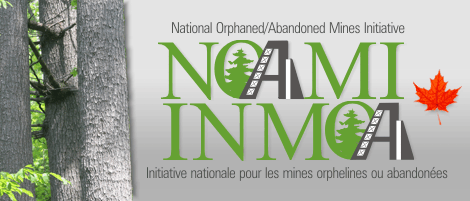Historical National Orphaned/Abandoned Mines Initiative
The Initiative was replaced in 2022 by the Annual Orphaned and Abandoned Mines Workshop
On this page
Overview
The National Orphaned/Abandoned Mines Initiative (NOAMI), launched in 2002, brought together federal, provincial, and territorial governments, industry, non-governmental organizations, and Indigenous organizations to address issues and make recommendations related to OAM sites in Canada. Its purpose was to study various issues and develop partnerships in the implementation of remediation programs across Canada. NOAMI undertook analyses and reviews, commissioned research studies, published public documents and information, including a web-based Inventory of Orphaned/Abandoned Mines, and organized multi-stakeholder workshops focused on specific issues relevant to OAM. The Initiative significantly contributed knowledge about the state of OAM in Canada, helped to build capacity, and influenced policy on the remediation of legacy sites.
In light of emerging issues such as climate change, a pan-Canadian initiative to re-imagine NOAMI was launched as part of the Canadian Minerals and Metals Plan’s Action Plan 2020. As a result, NOAMI was dissolved in 2022 after determining it had successfully met its original objectives that included:
- building a national inventory of OAM sites
- engaging communities
- identifying funding models, ownership and liability issues
- identifying areas where research could help jurisdictions advance remediation and prevent new occurrences
National Orphaned/Abandoned Mines Initiative governance
The NOAMI National Orphaned/Abandoned Mines Advisory Committee (the Advisory Committee) was established in 2002 at the request of Canadian Mines Ministers to study various issues and initiatives and develop partnerships in the implementation of remediation programs across Canada. The Advisory Committee was comprised of representatives of federal, provincial, and territorial governments, the mining industry, environmental non-governmental organizations, and Indigenous communities. It took direction from Mines Ministers and reported back through the Intergovernmental Working Group on the Mineral Industry (Mines IGWG).
The responsibilities of the Advisory Committee included providing strategic direction, developing and implementing action plans endorsed by Mines Ministers at their annual conference, as well as annual work plans, securing funding for the Initiative, establishing task groups and tracking their progress, preparing status reports and recommendations, and reviewing and approving publications.
Task Groups
Task groups were established to undertake in-depth analysis of a variety of issues and to provide recommendations and advice. Task groups focused on the following issues and activities:
- Information gathering/Inventory: To develop capacity for a national inventory of active, closed and orphaned/abandoned mine sites based on compatible inventories in each province and territory, including an acceptable system for categorization and priority ranking and agreed upon definitions and terminology.
- Community involvement: To develop a plan to foster community involvement in decision-making about closure and reclamation standards and ensure targeted end-use and reclamation standards were acceptable to local communities.
- Legislative and institutional barriers to collaboration: To evaluate the efficacy of various approaches to address barriers to collaboration.
- Funding approaches: To identify and evaluate funding approaches and preferred options to pay for the remediation of OAM sites that can be adapted to the needs of each jurisdiction.
- Jurisdictional legislative review: To develop guidelines for jurisdictional legislative reviews on collaboration, liability, and funding to ensure approaches are clear, consistent, transparent, coordinated, and efficient.
Key outcomes
National orphaned and abandoned mines inventory
While many mining jurisdictions maintain their own inventories of sites that pose a risk to health, safety, and the environment, a web-based national inventory of orphaned and abandoned mines was created in 2012 in partnership with the provinces and territories.
This original OAM inventory database served as the foundation for the new National Orphaned and Abandoned Mines Inventory and interactive map on the Open Science Data Platform, which continues to inform the closure and reclamation work at legacy mine sites across Canada.
The database for the National Inventory of Orphaned and Abandoned Mines has been updated several times since it was originally created. The updated database and the data dictionary can be downloaded here:
Publications
NOAMI produced a variety of publications, including case studies and analyses, annual action plans, annual status and performance reports, and periodic newsletters.
Publications (English only)
- Orphaned and Abandoned Mines: Risk Identification, Cost Estimation and Long-term Management (Kingsmere Resource Services Inc., 2016)
- Key Criteria for the Effective Long-term Stewardship of Closed, Orphaned/Abandoned Mine and Mineral Exploration Sites (Kingsmere Resource Services Inc., 2015)
- Case Studies and Decision Making Process for The Relinquishment of Closed Mine Sites (Cowan Minerals Ltd., 2013)
- The Policy Framework in Canada for Mine Closure and Management of Long-term Liabilities: A Guidance Document (Cowan Minerals Ltd., 2010)
- Report on the Legislative, Regulatory, and Policy Framework Respecting Collaboration, Liability, and Funding Measures in Relation to Orphaned and Abandoned, Contaminated, and Operating Mines in Canada (Joseph Castrilli, 2007)
- Rehabilitating Abandoned Mines in Canada: A Toolkit for Funding Options (Cowan Minerals Ltd., 2006)
- Capacity Building for a National Inventory of Orphaned/Abandoned Mines in Canada (Cal Data Ltd., 2005)
- Guidelines for Legislative Review (2005)
- Best Practices in Community Involvement: Planning for and Rehabilitating Abandoned and Orphaned Mines in Canada (2003) (This publication is also available in French)
- Lessons Learned on Community Involvement in the Remediation of Orphaned and Abandoned Mines - Case Studies and Analysis (2003)
- Potential Funding Approaches for Orphaned/Abandoned Mines in Canada (2003)
- Barriers to Collaboration: Orphaned/Abandoned Mines in Canada (Castrilli, 2002)
Please contact the CMMP Secretariat if you are interested in receiving a copy.
Contact us
Have questions? Interested in collaborating with us? Reach out to us by email at cmmp-pcmm@nrcan-rncan.gc.ca.

